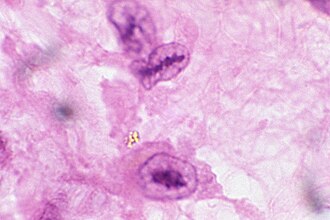Anitschkow cell
Anitschkow cells are a type of cell found in the heart tissue, particularly noted for their presence in conditions associated with rheumatic fever. They are named after the Russian pathologist Nikolai Anitschkow, who first described them in the early 20th century. Anitschkow cells are characterized by their distinct morphological feature, the caterpillar-like nucleus, due to the chromatin condensing along the nuclear membrane in a manner that resembles a string of beads. This unique appearance makes them easily identifiable under a microscope. They are primarily associated with the formation of Aschoff bodies, which are nodules found in the hearts of individuals with rheumatic fever, a disease that can follow untreated Streptococcus pyogenes infection, such as pharyngitis.
Characteristics
Anitschkow cells are most commonly found within the myocardium, the muscular tissue of the heart. These cells are not a separate cell type but are rather modified macrophages or fibroblasts that have undergone changes in response to the inflammatory process associated with rheumatic fever. The hallmark of these cells, the serpentine or caterpillar nucleus, is due to the arrangement of the DNA and proteins within the cell nucleus.
Role in Disease
The presence of Anitschkow cells is a diagnostic marker for rheumatic fever. Rheumatic fever is a sequela of pharyngeal infection by Streptococcus pyogenes, leading to a widespread inflammatory response. It can affect the heart, joints, skin, and brain — a condition known as rheumatic heart disease. The formation of Aschoff bodies, which contain Anitschkow cells, is a critical diagnostic feature observed in the heart tissue of affected individuals.
Clinical Significance
Identifying Anitschkow cells in heart tissue can help in diagnosing rheumatic fever, especially in cases where the clinical presentation is ambiguous. Their detection, along with other diagnostic criteria, can guide the treatment and management of the disease, potentially preventing the progression to rheumatic heart disease, which can have serious long-term consequences, including heart valve damage.
Research and Developments
Research into Anitschkow cells and their role in rheumatic fever continues to provide insights into the pathogenesis of the disease and the body's response to infection. Understanding the mechanisms behind the formation of Anitschkow cells and Aschoff bodies may lead to improved diagnostic and therapeutic strategies for rheumatic fever and its complications.
Transform your life with W8MD's budget GLP-1 injections from $125.
W8MD offers a medical weight loss program to lose weight in Philadelphia. Our physician-supervised medical weight loss provides:
- Most insurances accepted or discounted self-pay rates. We will obtain insurance prior authorizations if needed.
- Generic GLP1 weight loss injections from $125 for the starting dose.
- Also offer prescription weight loss medications including Phentermine, Qsymia, Diethylpropion, Contrave etc.
NYC weight loss doctor appointments
Start your NYC weight loss journey today at our NYC medical weight loss and Philadelphia medical weight loss clinics.
- Call 718-946-5500 to lose weight in NYC or for medical weight loss in Philadelphia 215-676-2334.
- Tags:NYC medical weight loss, Philadelphia lose weight Zepbound NYC, Budget GLP1 weight loss injections, Wegovy Philadelphia, Wegovy NYC, Philadelphia medical weight loss, Brookly weight loss and Wegovy NYC
|
WikiMD's Wellness Encyclopedia |
| Let Food Be Thy Medicine Medicine Thy Food - Hippocrates |
Medical Disclaimer: WikiMD is not a substitute for professional medical advice. The information on WikiMD is provided as an information resource only, may be incorrect, outdated or misleading, and is not to be used or relied on for any diagnostic or treatment purposes. Please consult your health care provider before making any healthcare decisions or for guidance about a specific medical condition. WikiMD expressly disclaims responsibility, and shall have no liability, for any damages, loss, injury, or liability whatsoever suffered as a result of your reliance on the information contained in this site. By visiting this site you agree to the foregoing terms and conditions, which may from time to time be changed or supplemented by WikiMD. If you do not agree to the foregoing terms and conditions, you should not enter or use this site. See full disclaimer.
Credits:Most images are courtesy of Wikimedia commons, and templates, categories Wikipedia, licensed under CC BY SA or similar.
Contributors: Prab R. Tumpati, MD

